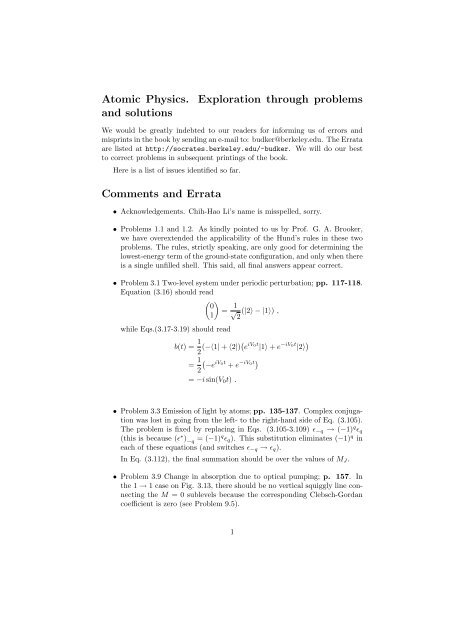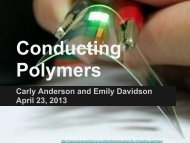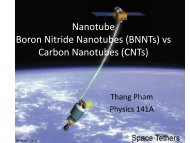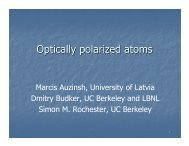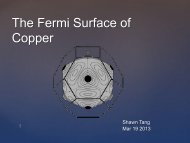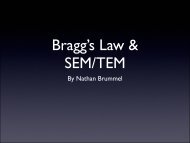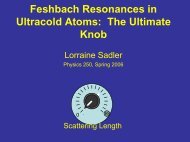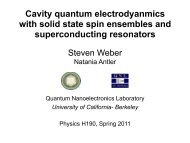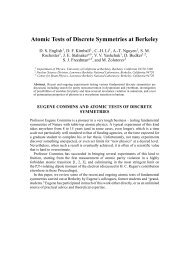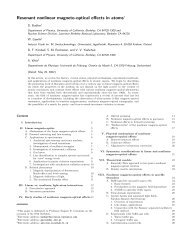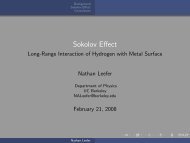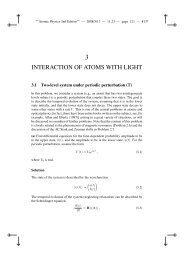Atomic Physics. Exploration through problems and solutions ...
Atomic Physics. Exploration through problems and solutions ...
Atomic Physics. Exploration through problems and solutions ...
You also want an ePaper? Increase the reach of your titles
YUMPU automatically turns print PDFs into web optimized ePapers that Google loves.
<strong>Atomic</strong> <strong>Physics</strong>. <strong>Exploration</strong> <strong>through</strong> <strong>problems</strong><br />
<strong>and</strong> <strong>solutions</strong><br />
We would be greatly indebted to our readers for informing us of errors <strong>and</strong><br />
misprints in the book by sending an e-mail to: budker@berkeley.edu. The Errata<br />
are listed at http://socrates.berkeley.edu/~budker. We will do our best<br />
to correct <strong>problems</strong> in subsequent printings of the book.<br />
Here is a list of issues identified so far.<br />
Comments <strong>and</strong> Errata<br />
• Acknowledgements. Chih-Hao Li’s name is misspelled, sorry.<br />
• Problems 1.1 <strong>and</strong> 1.2. As kindly pointed to us by Prof. G. A. Brooker,<br />
we have overextended the applicability of the Hund’s rules in these two<br />
<strong>problems</strong>. The rules, strictly speaking, are only good for determining the<br />
lowest-energy term of the ground-state configuration, <strong>and</strong> only when there<br />
is a single unfilled shell. This said, all final answers appear correct.<br />
• Problem 3.1 Two-level system under periodic perturbation; pp. 117-118.<br />
Equation (3.16) should read<br />
<br />
0<br />
=<br />
1<br />
1<br />
√ (|2〉 − |1〉) ,<br />
2<br />
while Eqs.(3.17-3.19) should read<br />
b(t) = 1<br />
2 (−〈1| + 〈2|)e iV0t <br />
−iV0t<br />
|1〉 + e |2〉<br />
iV0t −iV0t<br />
−e + e <br />
= 1<br />
2<br />
= −i sin(V0t) .<br />
• Problem 3.3 Emission of light by atoms; pp. 135-137. Complex conjugation<br />
was lost in going from the left- to the right-h<strong>and</strong> side of Eq. (3.105).<br />
The problem is fixed by replacing in Eqs. (3.105-3.109) ɛ−q → (−1) q ɛq<br />
(this is because (ɛ ∗ ) −q = (−1) q ɛq). This substitution eliminates (−1) q in<br />
each of these equations (<strong>and</strong> switches ɛ−q → ɛq).<br />
In Eq. (3.112), the final summation should be over the values of MJ.<br />
• Problem 3.9 Change in absorption due to optical pumping; p. 157. In<br />
the 1 → 1 case on Fig. 3.13, there should be no vertical squiggly line connecting<br />
the M = 0 sublevels because the corresponding Clebsch-Gordan<br />
coefficient is zero (see Problem 9.5).<br />
1
• Problem 3.10 Optical pumping <strong>and</strong> density matrix; p.<br />
(3.215) should read:<br />
163. Equation<br />
⎛<br />
1<br />
⎜<br />
ρ = ⎜0<br />
⎝0<br />
0<br />
0<br />
0<br />
0<br />
0<br />
0<br />
⎞<br />
0<br />
0 ⎟<br />
0⎠<br />
. (1.1)<br />
0 0 0 1<br />
Thanks to Andrew Dawes (Duke University) for pointing this out.<br />
• Problem 4.5 Stark-induced transition; pp. 203-207. In Eqs. (4.61-4.64),<br />
the denominators Ep − Em should all be replaced with Em − Ep (the<br />
En − Ep denominators are correct).<br />
Equation (4.68) should read<br />
T κ q = <br />
q1,q2<br />
〈1, q1, 1, q2|κ, q〉Eq1Eq2 .<br />
The sentence following Eq. (4.68) should be eliminated.<br />
There should be a comma at the end of Eq. (4.69), <strong>and</strong> a period at the<br />
end of Eq. (4.70).<br />
Equation (4.72) should read<br />
T 0 0 = − 1<br />
√ E ·<br />
3<br />
E .<br />
Additionally, “where a is a constant” should be eliminated.<br />
Equation (4.75) should read<br />
T 1 q = i<br />
<br />
√ E × E .<br />
2<br />
q<br />
Additionally, “where b is a constant” should be eliminated.<br />
Equation (4.76) should read<br />
Equation (4.82) should read<br />
T 2 q = E 1 ⊗ E 1 2<br />
q .<br />
As = − 1<br />
<br />
√ E · E 〈m|U<br />
3<br />
0 0 |n〉 + i<br />
√ (−1)<br />
2 q<br />
q <br />
E × E 〈m|U<br />
q<br />
1 −q|n〉<br />
+ <br />
q<br />
(−1) q E 1 ⊗ E 1 2<br />
q 〈m|U 2 −q|n〉 .<br />
2
Equations (4.83-4.84) <strong>and</strong> the discussion between them should read:<br />
As = − 1<br />
<br />
√ E · E 3<br />
′ 0 〈m, F ||U ||n, F 〉<br />
〈F, M, 0, 0|F ′ , M ′ 〉<br />
√ 2F ′ + 1<br />
+ i<br />
√ (−1)<br />
2 M−M ′ <br />
E × E q=M−M ′<br />
+ (−1) M−M ′ E 1 ⊗ E 1 κ=2<br />
q=M−M ′<br />
〈m, F ′ ||U 1 ||n, F 〉<br />
√ 〈F, M, 1, M<br />
2F ′ + 1<br />
′ − M|F ′ , M ′ 〉<br />
〈m, F ′ ||U 2 ||n, F 〉<br />
√ 〈F, M, 2, M<br />
2F ′ + 1<br />
′ − M|F ′ , M ′ 〉 .<br />
In the literature [see, for example, Bouchiat <strong>and</strong> Bouchiat (1975); Drell<br />
<strong>and</strong> Commins (1985); Bowers et al. (1999); Bennett <strong>and</strong> Wieman (1999)],<br />
the Stark-induced amplitude is defined in terms of the real parameters α,<br />
β, <strong>and</strong> γ, known as the scalar, vector, <strong>and</strong> tensor transition polarizabilities,<br />
respectively. These parameters correspond to the three terms in the<br />
above expression. Unfortunately, there does not seem to be a universal<br />
convention on how to normalize these parameters. In cases where the γ<br />
term is zero (see part (d)), α characterizes the Stark-induced amplitude<br />
for collinear static electric field <strong>and</strong> light polarization, while β characterizes<br />
the amplitude when the light polarization is orthogonal to the static<br />
field. In the case of transitions between s1/2 states (for example, the<br />
6s1/2 → 7s1/2 transition in Cs where parity-violation experiments have<br />
been carried out), the Stark-induced transition amplitude between states<br />
with total angular momenta F <strong>and</strong> F ′ can be conveniently written as<br />
As = α E · E δF,F ′δM,M ′ + iβ<br />
where σ is the Pauli spin operator.<br />
<br />
E × E · 〈F ′ M ′ |σ|F M〉 ,<br />
• Problem 5.4 Basic concepts in spin exchange; p. 239. Following Eq.<br />
(5.29), the second of the two Vt(r) should be Vs(r).<br />
• Problem 7.1 Amplitude of molecular vibrations; p. 291. The final formula<br />
in the second footnote should read<br />
De − D0 ≈ ωe<br />
2 .<br />
• Problem 7.4 Relative densities of atoms <strong>and</strong> molecules in a vapor; pp.<br />
298-301. Equation (7.38) should read<br />
F (T ; De, Be,ωe) = e De<br />
k B T<br />
×<br />
<br />
I<br />
∞<br />
J=0<br />
e −ωe<br />
2k B T<br />
ωe − k 1 − e B T<br />
(2I + 1)<br />
BeJ(J+1)<br />
− k (2J + 1)e B T +<br />
3<br />
∞<br />
J ′ =0<br />
(4J ′ + 3)e − Be(2J′ +1)(2J ′ <br />
+3)<br />
kB T<br />
.
Equation (7.41) should read<br />
e −ωe<br />
2kB T<br />
1 − e−ωe/(kBT kBT<br />
≈<br />
) ωe<br />
Equations (7.46) <strong>and</strong> (7.47) should read<br />
F (T ; De, Be, ωe) ≈ e De<br />
<br />
kBT<br />
kB T (2I + 1) I<br />
ωe<br />
kBT<br />
Be<br />
= e De<br />
kB T kBT kBT (2I + 1) 2<br />
.<br />
2<br />
Equation (7.48) should read<br />
NCs2<br />
N Cs<br />
≈ n Cs<br />
2 √ 2<br />
Equation (7.52) should read<br />
ωe<br />
<br />
h<br />
√<br />
2πmkBT<br />
Be<br />
.<br />
+ 1<br />
<br />
kBT<br />
2 Be<br />
3 e De<br />
<br />
kBT kBT<br />
kB T<br />
.<br />
ωe Be<br />
P [CGS] ≈ 1.33 × 10 3 P [torr],<br />
<strong>and</strong> the following equation should read<br />
Finally, Eqn. (7.54) should read<br />
The final paragraph should state:<br />
P (T ) ≈ 1.8 torr ≈ 2.4 × 10 3 [CGS] .<br />
NCs2<br />
(T = 22<br />
NCs ◦ C) ≈ 6.5 × 10 −5 .<br />
The difference in molecular abundance between these two temperatures is<br />
strongly affected by the difference in atomic Cs pressure; at room temperature<br />
this is only P ≈ 1 × 10 −6 torr, six orders of magnitude less than at<br />
T = 300 ◦ C.<br />
• Problem 7.7 Scalar coupling of nuclear spins in molecules; p. 312. Equation<br />
(7.101) should read:<br />
|g〉 = ψ1s(r1)ψ1s(r2) 1<br />
√ 2 (|α1β2〉 − |β1α2〉)| ↑〉 .<br />
4
• Problem 8.6 Transmission <strong>through</strong> a light guide; p. 325. We have neglected<br />
light reflection at the entrance. This may not be a realistic approximation,<br />
particularly, for large incidence angles α. See, for example,<br />
a discussion of the Fresnel’ formulae (<strong>and</strong> the corresponding plots of the<br />
reflection <strong>and</strong> transmission coefficients) in Ch. 3 of K. D. Möller’s book<br />
Optics, University Science Books, Mill Valey, California (1988).<br />
• Problem 8.14 Matter-wave vs. optical Sagnac gyroscopes; pp. 343, 346.<br />
The units of the gyroscope’s sensitivity should be rad/s<br />
√ t(s) , where t(s) is the<br />
duration of the measurement in seconds.<br />
• Problem 8.16 Magnetic field fluctuations due to r<strong>and</strong>om thermal currents;<br />
pp. 352. The inequality after Eq. (8.106) should read 1 ≤ C ≤ 2π.<br />
• References. Here are the corrected references.<br />
Budker, D., Hollberg, L., Kimball, D. F., Kitching, J., Pustelny, S., <strong>and</strong><br />
Yashchuk, V. V. (2003). Investigation of microwave transitions <strong>and</strong> nonlinear<br />
magneto-optical rotation in anti-relaxation-coated cells. Physical<br />
Review A, 71, 012903.<br />
Happer, W., Walker, T., <strong>and</strong> Bonin, K. (2003). Optical pumping: principles<br />
<strong>and</strong> applications. Springer-Verlag, Berlin. This book has not been<br />
published as yet (January 2006).<br />
Haroche, S. (1976). Quantum beats <strong>and</strong> time-resolved fluorescence spectroscopy,<br />
in High-resolution laser spectroscopy, K. Shimoda, Ed. Springer-<br />
Verlag, Berlin.<br />
5


